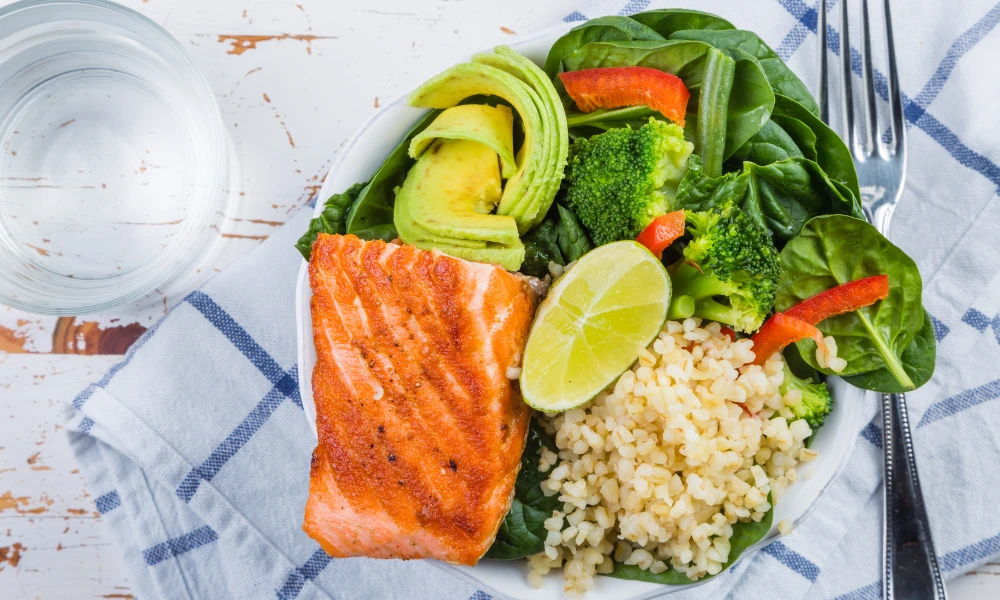The Perfect Plate Method offers a simple yet effective solution to help you make informed choices about what goes on your plate. This blog post will explore the key principles of the Perfect Plate Method and how it can contribute to a balanced and nutritious lifestyle.
Understanding the Perfect Plate Method
1. Divide Your Plate
The Perfect Plate Method encourages you to divide your plate into three main sections:
50% Vegetables: Load up on colorful, nutrient-rich vegetables to provide essential vitamins, minerals, and fiber.
25% Lean Proteins: Incorporate lean protein sources such as chicken, fish, tofu, or legumes to support muscle growth and repair.
25% Whole Grains or Starchy Vegetables: Opt for whole grains like quinoa or brown rice, or starchy vegetables like sweet potatoes, to fuel your body with sustained energy.
2. Portion Control
Controlling portion sizes is crucial for maintaining a healthy weight. The Perfect Plate Method emphasizes moderation, helping you avoid overeating while ensuring you get the nutrients your body needs.
Choose Your Go-To Foods
Selecting your go-to foods from each food group in the Perfect Plate Method can make healthy eating more enjoyable and sustainable. By having a variety of options, you can alternate between them to keep your meals exciting. Here are 10 examples for each of the three main food groups:

1. Vegetables (50% of your plate)
Broccoli: Packed with vitamins C and K, and fiber, broccoli is a versatile and nutritious vegetable.
Spinach: A nutrient powerhouse, spinach is rich in iron, vitamins A and K, and adds a vibrant touch to your plate.
Bell Peppers: Whether red, green, or yellow, bell peppers bring color and a dose of vitamin C to your meals.
Carrots: A crunchy and sweet option, carrots are high in beta-carotene and support eye health.
Cauliflower: An excellent source of vitamins and fiber, cauliflower is a great low-carb alternative.
Zucchini: Low in calories and high in water content, zucchini adds a light and refreshing element to your plate.
Kale: Packed with antioxidants and fiber, kale is a nutrient-dense leafy green.
Tomatoes: Rich in antioxidants and vitamins, tomatoes add flavor and juiciness to your dishes.
Brussels Sprouts: High in fiber and vitamins, Brussels sprouts offer a unique and hearty flavor.
Asparagus: A low-calorie vegtable rich in folate and vitamins, asparagus adds a touch of elegance to your meals.

2. Lean Proteins (25% of your plate)
Grilled Chicken Breast: A lean source of protein, grilled chicken is versatile and can be seasoned in various ways.
Salmon: Packed with omega-3 fatty acids, salmon is not only delicious but also supports heart health.
Tofu: A plant-based protein, tofu is a versatile option that absorbs the flavors of the dishes it’s cooked with.
Turkey Breast: Low in fat and high in protein, turkey is a lean and tasty choice.
Lentils: Rich in protein and fiber, lentils are a satisfying option for vegetarians and meat-lovers alike.
Shrimp: Low in calories and high in protein, shrimp adds a seafood flair to your meals.
Eggs: A budget-friendly protein source, eggs are versatile and can be enjoyed in various dishes.
Greek Yogurt: Packed with protein and probiotics, Greek yogurt is a nutritious dairy option.
Lean Beef (Sirloin or Tenderloin): In moderation, lean cuts of beef provide iron and high-quality protein.
Cottage Cheese: A high-protein dairy option, cottage cheese can be enjoyed on its own or incorporated into recipes.

3. Whole Grains or Starchy Vegetables (25% of your plate)
Quinoa: A complete protein source, quinoa is a versatile grain that adds a nutty flavor to your plate.
Brown Rice: A fiber-rich alternative to white rice, brown rice provides sustained energy.
Sweet Potatoes: Packed with vitamins and fiber, sweet potatoes add natural sweetness and color to your meals.
Oats: A whole grain that is high in fiber, oats are a filling and heart-healthy choice for breakfast.
Barley: Rich in fiber and nutrients, barley adds a chewy texture to soups and salads.
Whole Wheat Pasta: A healthier alternative to refined pasta, whole wheat pasta is higher in fiber.
Quinoa Pasta: Gluten-free and protein-rich, quinoa pasta is an excellent option for those with dietary restrictions.
Buckwheat: A nutrient-dense whole grain, buckwheat is a gluten-free option with a unique taste.
Butternut Squash: A delicious and vitamin-rich starchy vegetable, butternut squash can be roasted or pureed.
Farro: A ancient grain with a chewy texture, farro is rich in protein, fiber, and nutrients.

Benefits of the Perfect Plate Method
1. Nutrient-Rich Diet: By following the Perfect Plate Method, you ensure that your meals are packed with a variety of essential nutrients. This promotes overall well-being, supports immune function, and enhances your body’s ability to perform optimally.
2. Weight Management: The method’s focus on portion control and balanced nutrition aids in weight management. It helps prevent excess calorie intake and encourages a sustainable approach to maintaining a healthy weight.
3. Blood Sugar Regulation: Including a mix of complex carbohydrates, lean proteins, and fiber-rich vegetables helps regulate blood sugar levels. This can be particularly beneficial for individuals with diabetes or those looking to prevent blood sugar spikes.
Tips for Implementing the Perfect Plate Method
1. Meal Planning: Plan your meals in advance to ensure you have a variety of foods that align with the Perfect Plate Method. This can help you make healthier choices and resist the temptation of less nutritious options.
2. Incorporate Your Go-To Foods: Establish a list of your favorite go-to foods (see above) for each category—vegetables, lean proteins, and whole grains or starchy vegetables. Having these staples on hand makes meal planning and preparation more straightforward.
3. Experiment with Flavors: Make your meals exciting by experimenting with herbs, spices, and healthy sauces. This not only adds variety to your diet but also makes the Perfect Plate Method a sustainable and enjoyable approach to eating.
4. Stay Hydrated: Don’t forget the importance of hydration. Water plays a key role in digestion, nutrient absorption, and overall health. Aim to drink an adequate amount of water throughout the day.
Overcoming Common Challenges
1. Eating Out: When dining out, look for menu options that align with the Perfect Plate Method. Don’t hesitate to customize your order to ensure a balanced and nutritious meal.
2. Snacking Smartly: Choose healthy snacks that complement the Perfect Plate Method. Options like fresh fruit, nuts, or yogurt can help you stay on track between meals.
Conclusion
The Perfect Plate Method provides a practical and flexible approach to healthy eating. By incorporating this method into your daily routine, you can enjoy a balanced diet that supports your overall well-being. Remember, small changes can lead to significant improvements in your health, so start building your perfect plate today. Your body will thank you for it.




